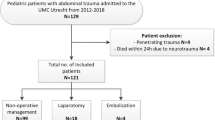Abstract
Trauma is the leading cause of death in children in developed countries. In tropical Africa, it is only beginning to assume importance as infections and malnutrition are controlled. In developed countries, the availability of advanced imaging modalities has now reduced the necessity for laparotomy to less than 10% following blunt abdominal trauma (BAT) in children. This report reviews the epidemiology, management, and unnecessary laparotomies for pediatric BAT in a developing country in a retrospective review of 57 children aged 15 years or less at the Ahmadu Bello University Teaching Hospital, Zaria, Nigeria over 12 years. The average age was 9 years and the male-female ratio 3.8:1. Seventy-four percent (74%) of abdominal injuries in children were due to blunt trauma. The commonest causes of injury were road traffic accidents (RTA) (57%), 88% in pedestrians and 59% in children aged 5–9 years. Falls were the cause of trauma in 36%, 60% of them aged 10–15 years. Other causes of injury were sports in 5% and animals in 2%. Diagnosis was clinical, supported by diagnostic peritoneal lavage or paracentesis. Two patients had ultrasonography, and none had computed tomography. Fifty-three patients had a laparotomy, 2 died before surgery, 1 was managed nonoperatively, and in 1 surgery was declined. There were 34 splenic injuries, 20 treated by splenic preservation, splenectomy in 13, and non-operative in 1. Fourteen gastrointestinal injuries were treated in 12 patients. Of 9 hepatic injuries, 4 were minor and were left untreated, 3 were repaired, 1 was packed to arrest hemorhage, and a lacerated accesory liver was excised. Four injuries to the urinary tract (bladder contusion 2, bladder rupture 1, ruptured hydronephrotic kidney 1) were treated accordingly. There were 4 retroperitoneal hematomas associated with other intra-abdominal injuries and 2 pancreatic contusions. One lacerated gallbladder was treated by cholecystectomy and a ruptured left hemidiaphragm was repaired transperitoneally. In retrospect, 27 (51%) patients could have been managed by observation (splenic injury 20, liver injury 5, bladder contusion 2) using advanced imaging modalities. One patient developed an intra-abdominal abscess following splenorrhaphy. The average hospital stay was 17 days. Mortality was 8 (14.5%) from gastric perforation (3), liver injury (2), splenic injury (1), and 2 patients died before surgery. BAT in this population results predominantly from RTA in pedestrians. Laparotomy may be avoided in 51% of cases if advanced imaging modalities are readily available.
Similar content being viewed by others
Author information
Authors and Affiliations
Additional information
Accepted: 28 October 1999
Rights and permissions
About this article
Cite this article
Ameh, E., Chirdan, L. & Nmadu, P. Blunt abdominal trauma in children: epidemiology, management, and management problems in a developing country. Pediatr Surg Int 16, 505–509 (2000). https://doi.org/10.1007/s003830000406
Issue Date:
DOI: https://doi.org/10.1007/s003830000406




